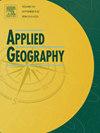National shared responsibility mechanism for carbon reduction: Addressing resource imbalances from interprovincial flows of virtual water-energy-carbon
IF 4
2区 地球科学
Q1 GEOGRAPHY
引用次数: 0
Abstract
Commodity trade influences the spatial distribution and interrelationships of virtual water‒energy‒carbon (WEC) systems, thereby affecting regional resource balance and equity in carbon emissions reductions. A triangular framework was established to evaluate the spatial flow and disparities of virtual WEC across 30 provinces in China. Significant differences were identified between the production and consumption sectors, highlighting a strong connection between energy and carbon, as well as a trade-off with water. Approximately 63% of the provinces demonstrated a moderate degree of coordination within the virtual WEC system, which was found to negatively correlate with their levels of social and economic development. The transfer of virtual WEC was observed from the less developed western and northern regions to the economically advanced southeastern coastal areas, exacerbating disparities in resource distribution and carbon emissions. Therefore, a joint shared responsibility mechanism for carbon reduction is proposed, utilizing the water fairness coefficient to assess inequities in responsibility arising from the spatial flow of virtual WEC. Nationally, it is recommended to intensify efforts in coordinating WEC management and implement a carbon compensation strategy for regions with disproportionate burdens. Provincially, optimizing and adjusting industrial structures is crucial to match regional balance characteristics and coupling coordination patterns.

国家碳减排责任分担机制:解决省际水-能源-碳虚拟流动带来的资源不平衡问题
商品贸易影响虚拟水-能源-碳系统的空间分布和相互关系,从而影响区域资源平衡和碳减排的公平性。建立了一个三角形框架,对中国30个省份虚拟世界经济价值的空间流动和差异进行了评价。在生产和消费部门之间发现了显著差异,突出了能源和碳之间的紧密联系,以及与水的权衡。大约63%的省份在虚拟WEC系统中表现出中等程度的协调,这与他们的社会和经济发展水平呈负相关。虚拟WEC从西部和北部欠发达地区向经济发达的东南沿海地区转移,加剧了资源分配和碳排放的差异。因此,本文提出了碳减排的共同责任机制,利用水公平系数来评估虚拟WEC空间流动所产生的责任不公平。在全国范围内,建议加大对WEC管理的协调力度,对负担不成比例的地区实施碳补偿战略。从全省看,优化调整产业结构是匹配区域平衡特征和耦合协调模式的关键。
本文章由计算机程序翻译,如有差异,请以英文原文为准。
求助全文
约1分钟内获得全文
求助全文
来源期刊

Applied Geography
GEOGRAPHY-
CiteScore
8.00
自引率
2.00%
发文量
134
期刊介绍:
Applied Geography is a journal devoted to the publication of research which utilizes geographic approaches (human, physical, nature-society and GIScience) to resolve human problems that have a spatial dimension. These problems may be related to the assessment, management and allocation of the world physical and/or human resources. The underlying rationale of the journal is that only through a clear understanding of the relevant societal, physical, and coupled natural-humans systems can we resolve such problems. Papers are invited on any theme involving the application of geographical theory and methodology in the resolution of human problems.
 求助内容:
求助内容: 应助结果提醒方式:
应助结果提醒方式:


